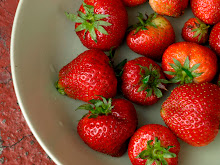
I’m just back from a cycling tour in the regions of Asturias and Galicia and plan to devote a few posts to my culinary experiences. First, a drink.
In Asturias, where we were only for about a day and a half, I had the feeling they were really into their
cider – hard cider (5-8% alcohol), know as natural cider (
sidra natural). We spent our first night in a fishing village called
Cudillero and the streets reeked of cider. I think the fact that they’d just had a fiesta didn’t help matters, but the peculiar way of pouring the cider was the main culprit.
When we ordered our cider, what made its way to the table was quite a large, green bottle, but only one glass. The reason for this, we were told, was that you have to share the glass, and the bottle. We weren’t allowed to pour it either. Only one waitress knew how to do that – see photo. This takes away some of the natural bitterness of the cider and gives it a bit of air (it tends to be a bit flat). The ‘shot’ they give you to drink in one or two gulps is called a
culín (little butt). Each person gets a quick drink and then you have to wait until they come back to give you another.

It’s a messy process, though our waitress was pretty good. Inevitably some gets on the ground, hence the smell of cider everywhere. Once we were thirsty and just poured a bit for ourselves. When the waitress saw, she came over, shocked, dumped it out onto the ground (we were outdoors) and poured it properly for us.
In the Basque country (especially somewhere like San Sebastián) they have similar cider. In bars it is shot out of a barrel of some sort and the cider has to be caught in the glass. The Spanish Pig (who was my traveling companion) recently went to an event at a sidrería in Navarra. They also had cider shot into the glass, but this time straight from the barrels used to preserve it (photo).

According to my guide to Asturian gastronomy (produced by the Principality itself), the Asturian cider is made from three different types of apples combined – sour, bitter and sweet. It’s quite dry and has a wonderful, almost smoky taste and should be golden in colour and can be a bit cloudy.
This site looks interesting if you’re hunting down real cider and they have a special link for Spain:
http://ukcider.co.uk/wiki/index.php/Main_Page










